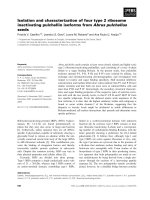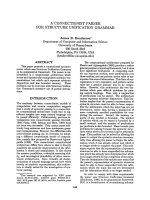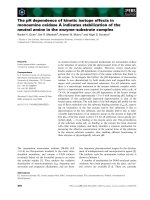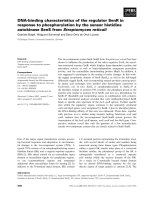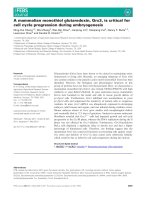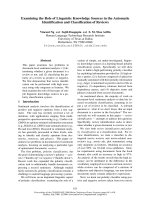báo cáo khoa học: "A case report of male breast cancer in a very young patient: What is changing" docx
Bạn đang xem bản rút gọn của tài liệu. Xem và tải ngay bản đầy đủ của tài liệu tại đây (846.66 KB, 5 trang )
CAS E REP O R T Open Access
A case report of male breast cancer in a very
young patient: What is changing?
Marcelo Madeira
1,2*
, André Mattar
1,3
, Rodrigo José Barata Passos
1
, Caroline Dornelles Mora
3
,
Luiz Henrique Beralde Vilar Mamede
2
, Viviane Hatsumi Kishino
2
, Thomas Zurga Markus Torres
2
,
Andressa Fernandes Rodrigues de Sá
2
, Roberto Euzébio dos Santos
2,3
, Luiz Henrique Gebrim
1,3
Abstract
Male breast cancer accounts for 1% of all breast cancer cases, and men tend to be diagnosed at an older age than
women (mean age is about 67 years). Several risk factors have been identified, such as genetic and hormonal
abnormalities.
The present study reported the case of a 25-year-old man who was diagnosed with an advanced invasive ductal
carcinoma; however, he did not have any important risk factors.
Even though more data is emerging about this disease, more efforts to understand risk factors, treatment options
and survival benefits are needed. In this case, we discussed the risk factors as well as the impaired fertility
associated with breast cancer ther apies.
Background
Breast cancer in men is rare, and it accounts for about
1% of all malignant breast neoplasm cases [1,2]. The
estimated incidence is 1 case for each 100,000 m en. In
the United States, about 1,910 new cases were diagnosed
in 2009, and 440 of these cases resulted in death [3].
Among the histologic types, invasive ductal carcinoma is
the most prevalent breast cancer in males, with an inci-
dence varying from 65 to 95% [2,4].
Male breast cancer has unimodal age-frequency distri-
bution with a pea k incidence at 71 years old. Conver-
sely, female breast cancer has a bimodal age-frequency
distribution with early-onset and late-onset peak inci-
dences at 52 and 72 years old, respectively [5].
This study examined a 25-year-old man without
import ant risk factors who was diagnosed with invasiv e
ductal carcinoma. Although it is rare, there have been
instances of breast cancer in younger males [6]. We
evaluated the main aspects of the epidemiology of
breast neoplasm in men and the best approach for
treatment.
Case presentation
A 25-year-old Brazilian male was referred to our institu-
tion in Au gust 2007 complaining of a breast tumor of
progressive growth f or the previous eight months. Pre-
vious medical and family history did not appear to con-
tribute to the present illness. He denied using drugs or
anabolic steroids and did not drink alcohol. The only
medication he was taking was phen obarbital, which he
had been taking for four years since he presented with
two seizure episodes. The patient was a smoker who
consumed 10 cigarett es per day. He also reported a nor-
mal sexual life, but he did not have children.
Physical examination revealed a 3.5 cm tumor located
on the right breast. There was a retraction of the nipple;
the nodule, which could be moved, had a harde ned con-
sistency and did not adhere to deep planes. The armpit s
did not present lymphadenopathy.
Mammographic find ings consisted of a noncalcified
high density mass (Figure 1) and breast ultrasonography
revealed a hypoechogenic nodule of irregular shape with
partially defined limits measuring 17 × 13 × 11 mm in
the right breast. The magnetic nuclear resonance imaging
showed a retroareolar nodule in the right b reast, which
corresponded to an expansive process. There were also
signs of infiltration of the pectoralis muscle and a small
area of retroareolar highlight in the left breast. Final
* Correspondence:
1
Senology Discipline, São Paulo Federal University, São Paulo, Brazil
Full list of author information is available at the end of the article
Madeira et al . World Journal of Surgical Oncology 2011, 9:16
/>WORLD JOURNAL OF
SURGICAL ONCOLOGY
© 2011 Madeira et al; licensee BioMed Central Ltd. This is an Open Access article distributed under the terms of the Creative Commons
Attribution License (http: //creati vecommons.org/li censes/by/2.0), which permits unrestricted use, distribut ion, and reproduction in
any medium, provided the original work is properly cited.
Breast Imaging Reporting and Data Sy stem (BI-RADS)
category was 5: highly suggestive of malignancy.
Fine-needle aspiration and a core biopsy of the lesion
were performed, and the diagnosis was invasive ductal car-
cinoma (Figure 2). After a recommended sperm cryopre -
servation, the patient started neoadjuvant chemoth erapy
(4 × FEC 100 + 1 cisplatin 75 with adriamycin 60). In
February 2008, the patient was submitted to a modified
radical mastectomy (right breast) and retroareolar lum-
pectomy (left breast) (Figure 3).
The anatomop athological analysis confirmed the diag-
nosis of invasive ductal carcinoma with a 3.0-cm lesion
in the biggest axle, which was histologic grade 2 and
nuclear grade 2. Final breast surgical margins were free,
but pectoralis muscle fascia and the nipple were infil-
trated. The axillary lymph n odes dissection did not
show any signs of cancer (0/8). In addition, immunohis-
tochemical staining of the tumor was posit ive for estro-
gen and progesterone receptors, and HER-2 negative
(Score 1). Although there were no signs of malignancy
or atypical hyperplasia in the left breast tissue, there was
fibrosclerosis and benign fibroadipose tissue.
The patient received adjuvant therapy along with
radiation therapy (5,000 cGy), and tamoxifen (20 mg/
day). Post-therapy follow-up were performed by mem-
bers of the treatment team and included regular physical
examinations and history. Liver function and alkaline
phosphatase tests were not indicated during the time
the patient was taking endocrine therapy. Although
reports have appeared about the dangers of liver damage
and hepatoma resulting from tamoxifen administration,
results from NSABP studies attest such concerns have
not been substantiated [7].
One year after the radiation therapy ended, the patient
presented with cervical and dorsal nodules, jaundice and
weight loss (about 20 kg). Evaluation of suspicious
recurrent breast cancer included physical exam, the per-
formance of a CBC, platelet count, liver function te sts,
chest imaging, bone scan and an abdomen ultrasound.
Blood tests results were negative for hepatitis A, B and
C, serum glutamic oxaloacetic transaminase 241 IU/L
(normal range: 10-34), serum alanine aminotransferase
187 IU/L (7-50), lactate dehydrogenase 358 U/L
(50-150), total bilirubin 8.69 mg/dl (0.3-1.9), direct bilir-
ubin 8.40 mg/dl (0-0.3) and alkaline phosphatase
959 IU/L (20-140).
In October 2009, the abdominal ultrasonography
showed the presence of several hepatic nodules. The
general state of the patient was deteriorating. He had a
variety of symptoms, including a lower level of con-
sciousness, dysphagia, inappetence, fever, cyanosis, a nd
dyspnea. The patient quickly developed multiple organ
failure and died in November 2009.
Because of weakness and quick deteri oration of health
state of the patient, it was not possible to perform a
biopsy documentation of recurrence and dete rmination
of hormone receptor status and HER-2 status.
Discussion
Invasive ductal carcinoma in men presents peculiar
features. About 42% of breast cancer cases in men are
diagnosed in stage III or IV [1]. This is probably because
men do not seek medical attention for breast masses as
quick ly as women. In addition, the tumor is usually clo-
ser to the skin in males, which increases the l ikel ihood
Figure 1 Mammographic findings. Noncalcified high density
mass of right breast.
Figure 2 Histological biopsy: invasive ductal carcinoma
(hematoxylin-eosin staining).
Madeira et al . World Journal of Surgical Oncology 2011, 9:16
/>Page 2 of 5
of infiltration into the dermis, which was reported in the
present case.
Treatment strategies for male breast cancer are not
basedondatafromrandomizedclinicalstudiesinmen
and most treatment recommendations are extrapolated
from data in women [8].
Men with breast carcinoma have a poor prognosis,
especially in the younger age group, because most breast
enlargements in young men are dismissed as gyneco-
mastia [9,10]. This potential misdiagnosis can result in
an unnecessary delay in treatment. The median age of
breast cancer diagnosis in men is approximately 65
years old [11]. Reports of breast cancer in young male
patients are rare. Nielsen and Jakobsen described a
breast cancer case in a 32-year-old man [12]. More
recently, an invasive cancer case was reported in a
30-year-old patient [9]. In 2008, Chang et al. described
the case of a 16-year-old male with unilateral ductal
carcinoma in situ and gynecomastia [13].
There is a close relation between the BRCA2 gene
mutation and male breast cancer. It has also been
observed, however, that some cases involve BRCA1
participation [14-16]. Other conditions that have been
associated with the occurrence of breast neoplasms in
men are cirrhosis [17], testicular trauma, obesity, radia-
tion therapy exposure, and the use of exogenous estro-
gen [18]. In addition to the very young age of the
patient in the present report, this patient did not have a
family, hormonal, or genetic history that could justify
the high risk for breast cancer. Although gynecomastia
has been suggested to be present in 6-38% of breast
cancer cases in men [19], it was not evident in our
patient.
It is fundamental to consider the history of breast
tumors in first-degree relatives because that can be an
indicator for increased breast cancer risk. Indeed,
genetic diseases such a s Klinefelter’ ssyndromeand
Cowden’ s disease have been shown to be related to
breast cancer in men [1].
There is no evidence that suggests that all men need
breast magnetic nuclear resonance imaging (MRI). But
suspicious MRI lesions in the contralateral breast should
be examined. Furthermore, male breast cancer survivors
have an increased risk of developing a second primary
Figure 3 Surgery. Modified radical mastectomy (right breast) and retroareolar lumpectomy (left breast).
Madeira et al . World Journal of Surgical Oncology 2011, 9:16
/>Page 3 of 5
cancer. The risk of a contralateral breast cancer appears
to be higher for men than it is for women [20]. Some
studies indicate that men with breast cancer have a 30-
fold increased risk of contralateral breast cancer, much
greater than the two- to fourfold risk among women
with breast cancer [21]. The risk of subsequent contral-
ateral breast cancer was highest for men aged less than
50 years at the time of the first cancer diagnosis, which
is consistent with studies of women with breast cancer
[22,23].
Estrogen receptors and progesterone receptors have
been suggested to play a role in breast cancers in men,
and they are present in about 90% and 81% of breast
cancers in males, respectively [4]. Furthermore, overex-
pression of the proto-oncogene HER-2 has been shown
topresenttheworstprognosisforapatient[24].Other
markers that have been recently studied are p27, MIB-1
and Bcl-2 genes.
Similar to breast cancer cases in women, earlier detec-
tion of male breast cancer is correlated with the success
of the treatment. Although males have considerably less
mammary parenchyma than women, the investigation
must be a combination of a clinical exam, mammogra-
phy, cytology, and percutaneous biopsies [25,26]. The
core needle biopsy is important because it enables a
definitive diagnosis of invasive breast cancer and t he
evaluation of estrogen receptors, progesterone receptors,
and Her-2 status [3].
Tamoxifen should still be considered as the optimal
adjuvant therapy option for male patients with endo-
crine responsive disease. The effect regarding r ate and
overall survival by adjuvant chemotherapy is also far less
well studied [8]. Some studies have demonstrated an
improved disease-free and overall survival compared
with historical controls using adjuvant anthracycline-
based therapies [4,5,27].
Because of the high probability of an indefinite period
of infertility following chemotherapy, sperm cryopr eser-
vation should be recommended for all young patients
with cancer prior to the start of chemotherapy.
Although treatment and survival represent the primary
goals of the clinical appr oach towards breast cancer
patients, the quality of life after treatment , including the
possibility of becoming fathers, requires consideration.
In addition, sperm cryopreservation is another hope that
encour ages young patients with cancer during and after
treatment [28].
Breast cancer therapeutics in men must be based on cer-
tain parameters, such as tumor size, the presence of estro-
gen and progesterone receptors, HER-2 expression, and
the association with other diseases. Men diagnosed with
breast cancer present risk factors, such as chronic hepato-
pathies, that are directly associated with the neoplasm. In
addition, men diagnosed with breast cancer are general ly
older and present other comorbidities. Due to the smaller
size of male mammary parenchyma, the elected surgical
treatment is modified radical mastectomy.
Conclusions
Invasive ductal carcinoma in young men is extremely
rare; the peak incidence is around the seventh decade of
life. Risk factors for male breast cancer include genetic
fact ors and hormonal abnormalities. Despite an absence
of a familial history of breast cancer, hormonal abnorm-
alities, or a genetic disease, the male patient in the pre-
sent study developed breast cancer at a very young age.
The causative factors in this patient were unable to be
definitively identified. The pathophysiology of breast
cancer in males is not adequately understood. As more
cases of breast cancer in young male patients are inves-
tigated, we may be able to gain a better understanding
of the mechanism.
Consent
Written informed consent was obtained from the
patient’s family for publication of this case report and
accompanying images. A copy of t he written consent is
available for review by the Editor-in-Chief of this journal.
Author details
1
Senology Discipline, São Paulo Federal University, São Paulo, Brazil.
2
Senology Discipline, UNINOVE University, São Paulo, Brazil.
3
Centro de
Referência da Saúde da Mulher (CRSM), São Paulo, Brazil.
Authors’ contributions
AM, RJBP, CDM and RES took part in the care of the patient. MM, LHBVM,
VHK, TZMT and AFRS were responsible for the literature review, design, and
writing of the manuscript. LHG was responsible for the manuscript
completion and critical review. All authors read and approved the final
manuscript.
Competing interests
The authors declare that they have no competing interests.
Received: 5 July 2010 Accepted: 3 February 2011
Published: 3 February 2011
References
1. Fentiman IS, Fourquet A, Hortobagyi GN: Male breast cancer. Lancet 2006,
367:595-604.
2. Gennari R, Curigliano G, Jereczek-Fossa BA, Zurrida S, Renne G, Intra M,
Galimberti V, Luini A, Orecchia R, Viale G, Goldhrisch A, Veronesi U: Male
breast cancer: a special therapeutic problem. Anything new? (Review).
Int J Oncol 2004, 24:663-670.
3. Jemal A, Siegel R, Ward E, Hao Y, Xu J, Thun MJ: Cancer statistics. CA
Cancer J Clin 2009, 59:225-249.
4. Giordano SH, Cohen DS, Buzdar AU, Perkins G, Hortobagyi GN: Breast
carcinoma in men: a population-based study. Cancer 2004, 101:51-57.
5. Anderson WF, Althuis MD, Brinton LA, Devesa SS: Is male breast cancer
similar or different than female breast cancer? Breast Cancer Res Treat
2004, 83:77-86.
6. Hill TD, Khamis HJ, Tyczynski JE, Berkel HJ: Comparison of male and
female breast cancer incidence trends, tumor characteristics, and
survival. Ann Epidemiol 2005, 15:773-780.
7. Fisher B, Costantino JP, Wickerham DL, Redmond CK, Kavanah M,
Cronin WM, Vogel V, Robidoux A, Dimitrov N, Atkins J, Daly M, Wieand S,
Madeira et al . World Journal of Surgical Oncology 2011, 9:16
/>Page 4 of 5
Tan-Chiu E, Ford L, Wolmark N: Tamoxifen for prevention of breast
cancer: report of the National Surgical Adjuvant Breast and Bowel
Project P-1 Study. J Natl Cancer Inst 1998, 90:1371-1388.
8. Czene K, Bergqvist J, Hall P, Bergh J: How to treat male breast cancer.
Breast 2007, 16(Suppl 2):S147-154.
9. Ahmad R, Lewis S, Maharaj D: A male patient from the West Indies with
invasive ductal carcinoma in the right breast: A case report and
literature review. Gend Med 2010, 7:179-183.
10. Giordano SH: A review of the diagnosis and management of male breast
cancer. Oncologist 2005, 10:471-479.
11. Cutuli B: Strategies in treating male breast cancer. Expert Opin
Pharmacother 2007, 8:193-202.
12. Nielsen US, Jakobsen EH: [Breast cancer in 32-year-old male]. Ugeskr
Laeger 2008, 170:1663.
13. Chang HL, Kish JB, Smith BL, Goldstein AM: A 16-year-old male with
gynecomastia and ductal carcinoma in situ. Pediatr Surg Int 2008,
24:1251-1253.
14. Frank TS, Deffenbaugh AM, Reid JE, Hulick M, Ward BE, Lingenfelter B,
Gumpper KL, Scholl T, Tavtigian SV, Pruss DR, Critchfield GC: Clinical
characteristics of individuals with germline mutations in BRCA1 and
BRCA2: analysis of 10,000 individuals. J Clin Oncol 2002, 20:1480-1490.
15. Friedman LS, Gayther SA, Kurosaki T, Gordon D, Noble B, Casey G,
Ponder BA, Anton-Culver H: Mutation analysis of BRCA1 and BRCA2 in a
male breast cancer population. Am J Hum Genet 1997, 60:313-319.
16. Haraldsson K, Loman N, Zhang QX, Johannsson O, Olsson H, Borg A: BRCA2
germ-line mutations are frequent in male breast cancer patients without
a family history of the disease. Cancer Res 1998, 58:1367-1371.
17. Misra SP, Misra V, Dwivedi M: Cancer of the breast in a male cirrhotic: is
there an association between the two? Am J Gastroenterol 1996,
91:380-382.
18. Ganly I, Taylor EW: Breast cancer in a trans-sexual man receiving
hormone replacement therapy. Br J Surg 1995, 82:341.
19. Colombo-Benkmann M, Stern J, Herfarth C: On the neglected entity of
unilateral gynecomastia. Ann Plast Surg 2006, 56:346.
20. Gomez-Raposo C, Zambrana Tevar F, Sereno Moyano M, Lopez Gomez M,
Casado E: Male breast cancer. Cancer Treat Rev 2010.
21. Auvinen A, Curtis RE, Ron E: Risk of subsequent cancer following breast
cancer in men. J Natl Cancer Inst
2002, 94:1330-1332.
22. Broet P, de la Rochefordiere A, Scholl SM, Fourquet A, Mosseri V,
Durand JC, Pouillart P, Asselain B: Contralateral breast cancer: annual
incidence and risk parameters. J Clin Oncol 1995, 13:1578-1583.
23. Cook LS, White E, Schwartz SM, McKnight B, Daling JR, Weiss NS: A
population-based study of contralateral breast cancer following a first
primary breast cancer (Washington, United States). Cancer Causes Control
1996, 7:382-390.
24. Bruce DM, Heys SD, Payne S, Miller ID, Eremin O: Male breast cancer:
clinico-pathological features, immunocytochemical characteristics and
prognosis. Eur J Surg Oncol 1996, 22:42-46.
25. Chantra PK, So GJ, Wollman JS, Bassett LW: Mammography of the male
breast. AJR Am J Roentgenol 1995, 164:853-858.
26. Volpe CM, Raffetto JD, Collure DW, Hoover EL, Doerr RJ: Unilateral male
breast masses: cancer risk and their evaluation and management. Am
Surg 1999, 65:250-253.
27. Giordano SH, Perkins GH, Broglio K, Garcia SG, Middleton LP, Buzdar AU,
Hortobagyi GN: Adjuvant systemic therapy for male breast carcinoma.
Cancer 2005, 104:2359-2364.
28. Saito K, Suzuki K, Iwasaki A, Yumura Y, Kubota Y: Sperm cryopreservation
before cancer chemotherapy helps in the emotional battle against
cancer. Cancer 2005, 104:521-524.
doi:10.1186/1477-7819-9-16
Cite this article as: Madeira et al.: A case report of male breast cancer in
a very young patient: What is changing? World Journal of Surgical
Oncology 2011 9:16.
Submit your next manuscript to BioMed Central
and take full advantage of:
• Convenient online submission
• Thorough peer review
• No space constraints or color figure charges
• Immediate publication on acceptance
• Inclusion in PubMed, CAS, Scopus and Google Scholar
• Research which is freely available for redistribution
Submit your manuscript at
www.biomedcentral.com/submit
Madeira et al . World Journal of Surgical Oncology 2011, 9:16
/>Page 5 of 5
